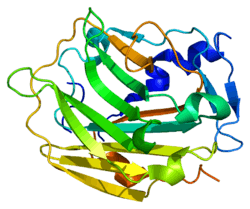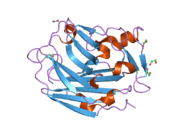Collagen, type IX, alpha 1
Collagen alpha-1(IX) chain is a protein that in humans is encoded by the COL9A1 gene.[3][4]
This gene encodes one of the three alpha chains of type IX collagen, a collagen component of hyaline cartilage. Type IX collagen is usually found in tissues containing type II collagen, a fibrillar collagen. Studies in knockout mice have shown that synthesis of the alpha 1 chain is essential for assembly of type IX collagen molecules, a heterotrimeric molecule, and that lack of type IX collagen is associated with early onset osteoarthritis. Mutations in this gene may be associated with multiple epiphyseal dysplasia. Two transcript variants have been identified for this gene.[4]
References
External links
Further reading
- Muragaki Y, Nishimura I, Henney A, et al. (1990). "The alpha 1 (IX) collagen gene gives rise to two different transcripts in both mouse embryonic and human fetal RNA.". Proc. Natl. Acad. Sci. U.S.A. 87 (7): 2400–4. doi:10.1073/pnas.87.7.2400. PMC 53696
 . PMID 1690886.
. PMID 1690886.
- Muragaki Y, Kimura T, Ninomiya Y, Olsen BR (1990). "The complete primary structure of two distinct forms of human alpha 1 (IX) collagen chains.". Eur. J. Biochem. 192 (3): 703–8. doi:10.1111/j.1432-1033.1990.tb19279.x. PMID 2209617.
- Fahrig T, Landa C, Pesheva P, et al. (1988). "Characterization of binding properties of the myelin-associated glycoprotein to extracellular matrix constituents.". EMBO J. 6 (10): 2875–83. PMC 553721
 . PMID 2446864.
. PMID 2446864.
- Kimura T, Mattei MG, Stevens JW, et al. (1989). "Molecular cloning of rat and human type IX collagen cDNA and localization of the alpha 1(IX) gene on the human chromosome 6.". Eur. J. Biochem. 179 (1): 71–8. doi:10.1111/j.1432-1033.1989.tb14522.x. PMID 2465149.
- Fitch JM, Mentzer A, Mayne R, Linsenmayer TF (1988). "Acquisition of type IX collagen by the developing avian primary corneal stroma and vitreous.". Dev. Biol. 128 (2): 396–405. doi:10.1016/0012-1606(88)90301-6. PMID 3294062.
- McCormick D, van der Rest M, Goodship J, et al. (1987). "Structure of the glycosaminoglycan domain in the type IX collagen-proteoglycan.". Proc. Natl. Acad. Sci. U.S.A. 84 (12): 4044–8. doi:10.1073/pnas.84.12.4044. PMC 305018
 . PMID 3473493.
. PMID 3473493.
- Richardson GP, Russell IJ, Duance VC, Bailey AJ (1987). "Polypeptide composition of the mammalian tectorial membrane.". Hear. Res. 25 (1): 45–60. doi:10.1016/0378-5955(87)90078-5. PMID 3542919.
- Robertson NG, Khetarpal U, Gutiérrez-Espeleta GA, et al. (1995). "Isolation of novel and known genes from a human fetal cochlear cDNA library using subtractive hybridization and differential screening.". Genomics. 23 (1): 42–50. doi:10.1006/geno.1994.1457. PMID 7829101.
- Warman ML, Tiller GE, Polumbo PA, et al. (1993). "Physical and linkage mapping of the human and murine genes for the alpha 1 chain of type IX collagen (COL9A1).". Genomics. 17 (3): 694–8. doi:10.1006/geno.1993.1391. PMID 8244386.
- Diab M, Wu JJ, Eyre DR (1996). "Collagen type IX from human cartilage: a structural profile of intermolecular cross-linking sites.". Biochem. J. 314 (1): 327–32. PMC 1217044
 . PMID 8660302.
. PMID 8660302.
- Pihlajamaa T, Vuoristo MM, Annunen S, et al. (1998). "Human COL9A1 and COL9A2 genes. Two genes of 90 and 15 kb code for similar polypeptides of the same collagen molecule.". Matrix Biol. 17 (3): 237–41. doi:10.1016/S0945-053X(98)90063-4. PMID 9707347.
- Paassilta P, Lohiniva J, Göring HH, et al. (2001). "Identification of a novel common genetic risk factor for lumbar disk disease.". JAMA. 285 (14): 1843–9. doi:10.1001/jama.285.14.1843. PMID 11308397.
- Czarny-Ratajczak M, Lohiniva J, Rogala P, et al. (2001). "A mutation in COL9A1 causes multiple epiphyseal dysplasia: further evidence for locus heterogeneity.". Am. J. Hum. Genet. 69 (5): 969–80. doi:10.1086/324023. PMC 1274373
 . PMID 11565064.
. PMID 11565064.
- Wistow G, Bernstein SL, Wyatt MK, et al. (2002). "Expressed sequence tag analysis of human RPE/choroid for the NEIBank Project: over 6000 non-redundant transcripts, novel genes and splice variants.". Mol. Vis. 8: 205–20. PMID 12107410.
- Zhang P, Jimenez SA, Stokes DG (2003). "Regulation of human COL9A1 gene expression. Activation of the proximal promoter region by SOX9.". J. Biol. Chem. 278 (1): 117–23. doi:10.1074/jbc.M208049200. PMID 12399468.
- Strausberg RL, Feingold EA, Grouse LH, et al. (2003). "Generation and initial analysis of more than 15,000 full-length human and mouse cDNA sequences.". Proc. Natl. Acad. Sci. U.S.A. 99 (26): 16899–903. doi:10.1073/pnas.242603899. PMC 139241
 . PMID 12477932.
. PMID 12477932.
- Mungall AJ, Palmer SA, Sims SK, et al. (2003). "The DNA sequence and analysis of human chromosome 6.". Nature. 425 (6960): 805–11. doi:10.1038/nature02055. PMID 14574404.
- Ota T, Suzuki Y, Nishikawa T, et al. (2004). "Complete sequencing and characterization of 21,243 full-length human cDNAs.". Nat. Genet. 36 (1): 40–5. doi:10.1038/ng1285. PMID 14702039.
- Pihlajamaa T, Lankinen H, Ylöstalo J, et al. (2004). "Characterization of recombinant amino-terminal NC4 domain of human collagen IX: interaction with glycosaminoglycans and cartilage oligomeric matrix protein.". J. Biol. Chem. 279 (23): 24265–73. doi:10.1074/jbc.M402865200. PMID 15047691.
- Gerhard DS, Wagner L, Feingold EA, et al. (2004). "The status, quality, and expansion of the NIH full-length cDNA project: the Mammalian Gene Collection (MGC).". Genome Res. 14 (10B): 2121–7. doi:10.1101/gr.2596504. PMC 528928
 . PMID 15489334.
. PMID 15489334.
PDB gallery |
|---|
|
| 2uur: N-TERMINAL NC4 DOMAIN OF COLLAGEN IX |
|
|


 . PMID 1690886.
. PMID 1690886. . PMID 2446864.
. PMID 2446864. . PMID 3473493.
. PMID 3473493. . PMID 8660302.
. PMID 8660302. . PMID 11565064.
. PMID 11565064. . PMID 12477932.
. PMID 12477932. . PMID 15489334.
. PMID 15489334.